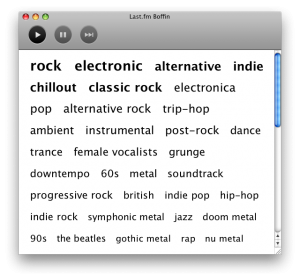 Recently I have read about an Israeli startup that plans to introduce a product called WebTVplug, which allows to connect the TV to the Internet through a hardware plug-in. The plug-in converts IP data, streamed from company’s server’s, to video signal, consumable by TV, and presents to the viewer a mesh of video clips, collected from the web, grouped by categories and sorted by company’s content editors.
Recently I have read about an Israeli startup that plans to introduce a product called WebTVplug, which allows to connect the TV to the Internet through a hardware plug-in. The plug-in converts IP data, streamed from company’s server’s, to video signal, consumable by TV, and presents to the viewer a mesh of video clips, collected from the web, grouped by categories and sorted by company’s content editors.
The problem of this product, is that instead of adjusting the content for the TV medium, it simply gives access to myriads of short clips from around the net in YouTube style (without the social aspect of YouTube).
The entertainment experience in the living room is inherently a passive one. Large display, soft sofa, remote control, a cup of tea. People want to relax, to be entertained, to be immersed by the movie they watching or the game the playing. While some may say that playing video games is not a passive entertainment, I would argue that it is in the sense that it does not require mental activities such as reading, browsing, searching, deciding – all those things we do on the web, and don’t do while watching TV or playing video games.
But the service constantly requires our attention and intervention, to select the next clip to watch. Which for short clips happens quite often. Since the amount of content is enormous, sooner or later we are drawn into a decision paralysis. It seams to me that most people would find this experience tiresome, and not fitting with what they come to expect from living room entertainment.
The idea of bringing Internet content to the living room has undeniable potential, but it seams to me that this product goes in the wrong direction.
If I would have tried to bring web video to TV, I would have focused on the following design aspects:
- Push, Not Pull – the user shouldn’t be asked to constantly make decisions, but rather be fed with self-streaming and self-updating content
- Embrace the TV – the layout, the fonts, the menus of the UI should be specifically designed for large displays, viewed from a distance. The input method ideally should be TV’s native remote control.
- Fuse with the Web – since the content is streamed from the Internet, it is possible to give each user experience customized for his unique taste. Instead of offloading on the unsuspecting user countless videos, sorted by category, but intended for everyone, it is possible to try to learn each user’s taste, and offer each one content, tailored specifically for his interests. This can be done by providing supplementary web service, through which user can teach the system of his taste, for example by feeding his YouTube’s account favorites.
On a side note, the service has an option of connecting the plug-in to PC, and streaming video clips. Its not clear why would anyone want to use this feature, when he has access to YouTube and other popular web video services.
The original post (in Hebrew): http://www.ynet.co.il/articles/0,7340,L-3782742,00.html
When talking about web video on TV, I should mention of course Boxee, which is a great example of web-to-TV product done right.



